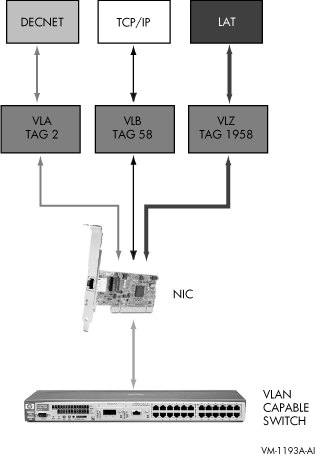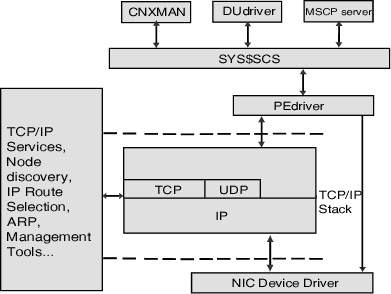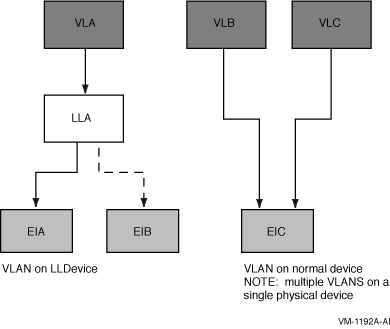HP OpenVMS Cluster Systems
2.10.1 Controlling Queues
To control queues, you use one or several queue managers to maintain a
clusterwide queue database that stores information about queues and
jobs.
Reference: For detailed information about setting up
OpenVMS Cluster queues, see Chapter 7.
Chapter 3
OpenVMS Cluster Interconnect Configurations
This chapter provides an overview of various types of OpenVMS Cluster
configurations and the ways they are interconnected.
For definitive information about supported OpenVMS Cluster
configurations, see:
- OpenVMS Cluster Software Software Product Description (SPD
29.78.xx)
- Guidelines for OpenVMS Cluster Configurations
3.1 Overview
Every node in an OpenVMS Cluster must have direct connections to all
other nodes. Sites can choose to use one or more of the following
interconnects:
- LANs
- Ethernet (Fast Ethernet, Gigabit Ethernet, 10 Gigabit Ethernet)
- Internet Protocol (IP)
- Ethernet (Fast Ethernet, Gigabit Ethernet, 10 Gigabit Ethernet)
- MEMORY CHANNEL (Alpha only)
- SMCI (Shared memory CI) (Alpha only) in OpenVMS Galaxy
configurations, as described in the HP OpenVMS Alpha Partitioning and Galaxy Guide
- SCSI (supported only as a node-to-storage interconnect, requires a
second interconnect for node-to-node (SCS) communications for limited
configurations)
- Fibre Channel (supported only as a node-to-storage interconnect,
requires a second interconnect for node-to-node (SCS) communications)
- SAS (supported only as a node-to-storage interconnect, requires a
second interconnect for node-to-node (SCS) communications for limited
configurations) (Integrity servers only)
Processing needs and available hardware resources determine how
individual OpenVMS Cluster systems are configured. The configuration
discussions in this chapter are based on these physical interconnects.
You can use bridges or switches to connect the OpenVMS Integrity server
nodes Fast Ethernet/Gigabit Ethernet NIC(s) to any intersite
interconnect the WAN supplier provides, such as [D]WDM, Gigabit
Ethernet, Fibre Channel or others.
Note
Multihost shared storage on a SCSI interconnect, commonly known as SCSI
clusters, is not supported. It is also not supported on OpenVMS Alpha
systems for newer SCSI adapters. However, multihost shared storage on
industry-standard Fibre Channel is supported.
Locally attached storage, on both OpenVMS Alpha systems (FC or SCSI
storage) and OpenVMS Integrity server systems (Fibre Channel, SAS, or
SCSI storage), can be served to any other member of the cluster.
|
3.2 OpenVMS Cluster Systems Interconnected by LANs
All Ethernet interconnects are industry-standard local area
networks that are generally shared by a wide variety of network
consumers. When OpenVMS Cluster systems are based on LAN, cluster
communications are carried out by a port driver (PEDRIVER) that
emulates CI port functions.
3.2.1 Design
The OpenVMS Cluster software is designed to use the Ethernet and
interconnects simultaneously with the DECnet, TCP/IP, and SCS
protocols. This is accomplished by allowing LAN data link software to
control the hardware port. This software provides a multiplexing
function so that the cluster protocols are simply another user of a
shared hardware resource. See Figure 2-1 for an illustration of this
concept.
3.2.1.1 PEDRIVER Fast Path Support
PEdriver, the software that enables OpenVMS Cluster communications over
a LAN, also provides Fast Path support. This PEdriver feature provides
the following benefits:
- Improves SMP performance scalability.
- Reduces the contention for the SCS/IOLOCK8 spinlock. PEdriver uses
a private port mainline spinlock to synchronize its internal operation.
- Allows PEdriver to perform cluster communications processing on a
secondary CPU, thus offloading the primary CPU.
- Allows PEdriver to process cluster communications using a single
CPU.
- Reduces CPU cost by providing a Fast Path streamlined code path for
DSA and served blocked data operations.
For more detailed information, see the HP OpenVMS I/O User's
Reference Manual, the HP OpenVMS System Manager's Manual,
and the HP OpenVMS System Management Utilities Reference
Manual.
3.2.2 Cluster Group Numbers and Cluster Passwords
A single LAN can support multiple LAN-based OpenVMS Cluster systems.
Each OpenVMS Cluster is identified and secured by a unique cluster
group number and a cluster password. Chapter 2 describes cluster
group numbers and cluster passwords in detail.
3.2.3 Servers
OpenVMS Cluster computers interconnected by a LAN are generally
configured as either servers or satellites. The following table
describes servers.
| Server Type |
Description |
|
MOP servers
|
Downline load the OpenVMS boot driver to satellites by means of the
Maintenance Operations Protocol (MOP).
|
|
Disk servers
|
Use MSCP server software to make their locally connected disks
available to satellites over the LAN.
|
|
Tape servers
|
Use TMSCP server software to make their locally connected tapes
available to satellite nodes over the LAN.
|
|
Boot servers
|
A combination of a MOP server and a disk server that serves one or more
Alpha system disks. Boot and disk servers make user and application
data disks available across the cluster. These servers must be the most
powerful computers in the OpenVMS Cluster and must use the
highest-bandwidth LAN adapters in the cluster. Boot servers must always
run the MSCP server software.
|
3.2.4 Satellites
Satellites are computers without a local system disk.
Generally, satellites are consumers of cluster resources, although they
can also provide facilities for disk serving, tape serving, and batch
processing. If satellites are equipped with local disks, they can
enhance performance by using such local disks for paging and swapping.
Satellites are booted remotely from a boot server (or from a MOP server
and a disk server) serving the system disk. Section 3.2.5 describes MOP
and disk server functions during satellite booting.
3.2.5 Satellite Booting (Alpha)
When a satellite requests an operating system load, a MOP server for
the appropriate OpenVMS Alpha operating system sends a bootstrap image
to the satellite that allows the satellite to load the rest of the
operating system from a disk server and join the cluster. The sequence
of actions during booting is described in Table 3-1.
Table 3-1 Satellite Booting Process
| Step |
Action |
Comments |
|
1
|
Satellite requests MOP service.
|
This is the original boot request that a satellite sends out across the
network. Any node in the OpenVMS Cluster that has MOP service enabled
and has the LAN address of the particular satellite node in its
database can become the MOP server for the satellite.
|
|
2
|
MOP server loads the Alpha system.
|
The MOP server responds to an Alpha satellite boot request by downline
loading the SYS$SYSTEM:APB.EXE program along with the required
parameters.
For Alpha computers, Some of these parameters include:
- System disk name
- Root number of the satellite
|
|
3
|
Satellite finds additional parameters located on the system disk and
root.
|
The satellite finds OpenVMS Cluster system parameters, such as
SCSSYSTEMID, SCSNODE, and NISCS_CONV_BOOT. The satellite also finds the
cluster group code and password.
|
|
4
|
Satellite executes the load program
|
The program establishes an SCS connection to a disk server for the
satellite system disk and loads the SYSBOOT.EXE program.
|
Configuring and starting a satellite booting service for Alpha
computers is described in detail in Section 4.5.
3.2.6 Satellite Booting (Integrity servers)
Configuring and starting a satellite booting service for Integrity
server systems is described in detail in Section 4.5.
3.2.7 Configuring Multiple LAN Adapters
LAN support for multiple adapters allows PEDRIVER (the port driver for
the LAN) to establish more than one channel between the local and
remote cluster nodes. A channel is a network path
between two nodes that is represented by a pair of LAN adapters.
3.2.7.1 System Characteristics
OpenVMS Cluster systems with multiple LAN adapters have the following
characteristics:
- At boot time, all Ethernet adapters are automatically
configured for local area OpenVMS Cluster use.
- PEDRIVER automatically detects and creates a new channel between
the local node and each remote cluster node for each unique pair of LAN
adapters.
- Channel viability is monitored continuously.
- In many cases, channel failure does not interfere with node-to-node
(virtual circuit) communications as long as there is at least one
remaining functioning channel between the nodes.
3.2.7.2 System Requirements
Configurations for OpenVMS Cluster systems with multiple LAN adapters
must meet the following requirements:
- The MOP server and the system disk server for a given satellite
must be connected to the same extended LAN segment. (LANs can be
extended using bridges that manage traffic between two or more local
LANs.)
- All nodes must have a direct path to all other nodes. A direct
path can be a bridged or a nonbridged LAN segment.
Rule: For each node, DECnet for OpenVMS (Phase IV) and
MOP serving (Alpha or VAX, as appropriate) can be performed by only one
adapter per extended LAN to prevent LAN address duplication.
3.2.7.3 Guidelines
The following guidelines are for configuring OpenVMS Cluster systems
with multiple LAN adapters. If you configure these systems according to
the guidelines, server nodes (nodes serving disks, tape, and lock
traffic) can typically use some of the additional bandwidth provided by
the added LAN adapters and increase the overall performance of the
cluster. However, the performance increase depends on the configuration
of your cluster and the applications it supports.
Configurations with multiple LAN adapters should follow these
guidelines:
- Connect each LAN adapter to a separate LAN segment. A LAN segment
can be bridged or nonbridged. Doing this can help provide higher
performance and availability in the cluster. The LAN segments can be
Ethernet segments.
- Distribute satellites equally among the LAN segments. Doing this
can help to distribute the cluster load more equally across all of the
LAN segments.
- Systems providing MOP service should be distributed among the LAN
segments to ensure that LAN failures do not prevent satellite booting.
Systems should be bridged to multiple LAN segments for performance and
availability.
- For the number of LAN adapters supported per node, refer to the
OpenVMS Cluster Software SPD.
3.2.8 LAN Examples
Figure 3-1 shows an OpenVMS Cluster system based on a LAN
interconnect with a single Alpha server node and a single Alpha system
disk.
Figure 3-1 LAN OpenVMS Cluster System with Single Server Node
and System Disk

In Figure 3-1, the server node (and its system disk) is a single
point of failure. If the server node fails, the satellite nodes cannot
access any of the shared disks including the system disk. Note that
some of the satellite nodes have locally connected disks. If you
convert one or more of these into system disks, satellite nodes can
boot from their own local system disk.
3.2.9 Fast Path for LAN Devices
With OpenVMS Version 7.3-2, further enhancements have been made to Fast
Path for LAN devices, which will continue to help streamline I/O
processing and improve symmetric-multiprocessing (SMP) performance
scalability on newer AlphaServer systems. Enhancements include:
- Reduced contention for the SCS/IOLOCK8 spinlock. The LAN drivers
now synchronize using a LAN port-specific spinlock where possible.
- Offload of the primary CPU. The LAN drivers may be assigned to a
secondary CPU so that I/O processing can be initiated and completed on
the secondary CPU. This offloads the primary CPU and reduces cache
contention between processors.
These features enhance the Fast Path functionality that already exist
in LAN drivers. The enhanced functionality includes additional
optimizations, preallocating of resources, and providing an optimized
code path for mainline code.
For more information, see the HP OpenVMS I/O User's Reference
Manual
3.2.10 LAN Bridge Failover Process
The following table describes how the bridge parameter settings can
affect the failover process.
| Option |
Comments |
|
Decreasing the LISTEN_TIME value allows the bridge to detect topology
changes more quickly.
|
If you reduce the LISTEN_TIME parameter value, you should also decrease
the value for the HELLO_INTERVAL bridge parameter according to the
bridge-specific guidelines. However, note that decreasing the value for
the HELLO_INTERVAL parameter causes an increase in network traffic.
|
|
Decreasing the FORWARDING_DELAY value can cause the bridge to forward
packets unnecessarily to the other LAN segment.
|
Unnecessary forwarding can temporarily cause more traffic on both LAN
segments until the bridge software determines which LAN address is on
each side of the bridge.
|
Note: If you change a parameter on one LAN bridge, you
should change that parameter on all bridges to ensure that selection of
a new root bridge does not change the value of the parameter. The
actual parameter value the bridge uses is the value specified by the
root bridge.
3.2.11 Virtual LAN Support in OpenVMS
Virtual LAN (VLAN) is a mechanism for segmenting a LAN broadcast domain
into smaller sections. The IEEE 802.1Q specification defines the
operation and behavior of a VLAN. The OpenVMS implementation adds IEEE
802.1Q support to selected OpenVMS LAN drivers so that OpenVMS can now
route VLAN tagged packets to LAN applications using a single LAN
adapter.
You can use VLAN to do the following:
- Segment specific LAN traffic on a network for the purposes of
network security or traffic containment, or both.
- Use VLAN isolated networks to simplify address management.
3.2.11.1 VLAN Design
In OpenVMS, VLAN presents a virtual LAN device to LAN applications. The
virtual LAN device associates a single IEE 802.1Q tag with
communications over a physical LAN device. The virtual device provides
the ability to run any LAN application (for example, SCA, DECnet,
TCP/IP, or LAT) over a physical LAN device, allowing host-to-host
communications as shown in Figure 3-2.
Note
DECnet-Plus and DECnet Phase IV can be configured to run over a VLAN
device.
|
Figure 3-2 Virtual LAN

OpenVMS VLAN has been implemented through a new driver,
SYS$VLANDRIVER.EXE, which provides the virtual LAN devices. Also,
existing LAN drivers have been updated to handle VLAN tags. LANCP.EXE
and LANACP.EXE have been updated with the ability to create and
deactivate VLAN devices and to display status and configuration
information.
The OpenVMS VLAN subsystem was designed with particular attention to
performance. Thus, the performance cost of using VLAN support is
negligible.
When configuring VLAN devices, remember that VLAN devices share the
same locking mechanism as the physical LAN device. For example, running
OpenVMS cluster protocol on a VLAN device along with the underlying
physical LAN device does not result in increased benefit and might, in
fact, hinder performance.
3.2.11.2 VLAN Support Details
All supported Gigabit and 10-Gb (Integrity servers-only) LAN devices
are capable of handling VLAN traffic on Alpha and Integrity server
systems.
The following list describes additional details of VLAN-related support:
3.3 Cluster over IP
OpenVMS Version 8.4 has been enhanced with the Cluster over IP
(Internet Protocol) feature. Cluster over IP provides the ability to
form clusters beyond a single LAN or VLAN segment using industry
standard Internet Protocol. This feature provides improved disaster
tolerant capability.
System managers also have the ability to manage or monitor OpenVMS
cluster that uses IP for cluster communication using SCACP management
utility.
Cluster protocol (SCS also known as SCA) over LAN is provided by Port
Emulator driver (PEDRIVER). PEDRIVER uses User Datagram Protocol (UDP)
and IP in addition to directly using 802.3 interfacing with LAN for
cluster communication as shown in Figure 1-0. The datagram
characteristics of UDP combined with PEDRIVER's inbuilt reliable
delivery mechanism is used for transporting cluster messages which is
used by SYSAP (system level application) to communicate between two
cluster nodes.
Cluster over IP is an optional feature that can be enabled in addition
to the traditional LAN based communication. However, if both LAN and IP
mode of communication exist between nodes in a cluster, PEDRIVER
prefers LAN communication instead of IP.
Note
OpenVMS Cluster over IP and IP Cluster Interconnect (IPCI) terms are
interchangeably used in the document and refers to using TCP/IP stack
for cluster communication.
|
3.3.1 Design
Cluster over IP solution is an integration of the following:
- PEDRIVER support for UDP protocol
- TCP/IP Services boot time loading and initialization
Figure 3-4 shows the cluster over IP architecture.
Figure 3-4 Cluster Communication Design Using IP

3.3.1.1 PEDRIVER Support for UDP
This consists of enhancing PEdriver to use the IP UDP protocol. Some of
the features of this solution include:
- The IP UDP service has the same packet delivery characteristics as
802 LANs. PEDRIVER implements the transport layer of NISCA which has
inbuilt delay probing, reliable delivery for sequenced messages
(retransmission), implement datagram service and also variable buffer
size for block transfers for I/O suitable for cluster traffic.
- The kernel VCI (KVCI) is a kernel mode. It acts as a highly
efficient interface to the HP OpenVMS TCP/IP Services stack. It is a
variant of the VCI interface, which PEdriver uses to communicate with
OpenVMS LAN drivers. PEDRIVER interfaces to UDP similar to a LAN device.
- Only the lowest layer of PEDRIVER is extended to support UDP. The
PEDRIVER changes are transparent to PEDRIVER's upper layers.
- Providing management interface ability to control and configure IP
interfaces to PEDRIVER.
3.3.1.2 TCP/IP Services Boot Time Loading and Initialization
To ensure that cluster communication is available in an IP only network
environment, it is essential to have TCP/IP stack loaded when the
cluster formation starts. This also retains the existing functionality
of cluster formation of OpenVMS clusters. Normal booting sequence
includes loading of LAN drivers followed by PEDRIVER. TCP/IP drivers
are loaded when TCP/IP services are started. If cluster over IP is
enabled, LAN, TCP/IP excelets, and PEDRIVER are loaded sequentially.
Once the system comes up, TCP/IP services can be started to use other
TCP/IP components, such as TELNET, FTP and so on.
Note
Ensure that the TCP/IP software is configured before configuring
cluster over IP. To ensure that network and TCP/IP is configured
properly, use the PING utility and ping the node from outside the
subnet.
|



